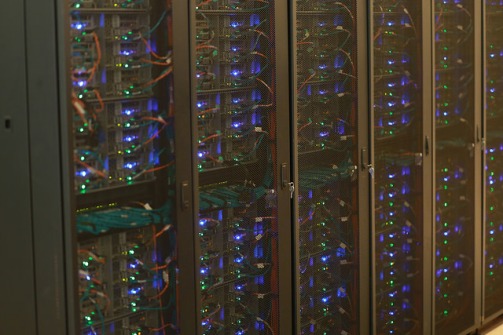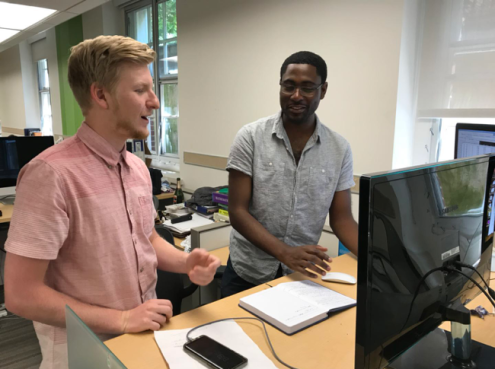When talking about chemists, what image comes to your mind? Labs, tubes, beakers, colorful solutions, turning dirt into gold… Yes, yes, those images represent some parts of chemistry in a general way, but did you know that there exists a group of chemists whose main task is to code? (For example, check out this video.) These chemists develop and use computer software to model real-world processes. By modeling real-world physical phenomena through the computer, they (and I) can simulate things that seem relatively simple, like ice melting into water, or more complicated things, like the binding behavior of proteins. We are called computational chemists.

I’ll be honest with you, I had never heard about computational chemists before I became one of them and now I love modeling different molecules and reactions. Scientists use models to supplement experimental research or develop new theories. One cool aspect of doing computational research is that we get a chance to use “super computers”. (Figure 1) The cluster (a set of computers that work together to achieve high computing power) at Maryland Advanced Research Computing Center (MARCC) is the super computer that I’m using and sharing with other researchers. As a computational chemistry student, I code the input files for the simulation, remotely connect to the super computer, and submit my work order for the clusters to calculate. After the simulation is done, I download it back onto my personal computer, perform post-simulation analysis, and see what has resulted.
What makes a super computer super? MARCC has a total of 19,776 cores. As a reference, a high-end personal computer typically has 4 cores. After doing some simple algebra, dividing 19,776 by 4, we can see that a powered-up super computer is as strong as almost 5,000 personal computers running together! The simulations I normally do take about 3 days to run on 100 cores on a super computer. If I were to use my standard laptop, it would presumably take 75 days (100/4×3=75), if not longer. Time is money, isn’t it? Therefore, super computers are invaluable resources to computational chemists.

So what’s it like to be a computational chemist? I decided to get information from some of the people around me who have a passion for computational chemistry.
The Professor
Rigoberto Hernandez is a computational and theoretical scientist at Johns Hopkins University. Professor Hernandez is my supervisor for Summer 2018 and he describes himself as being kind of like a Jedi Knight when he does computational chemistry: being a computational chemist means teaching and learning. There’s an apprenticeship between the students and the professor, just like experienced Jedi knights lead and train a generation of future Jedi Knights, and together they solve challenging scientific problems.

The Undergraduate Student
Let’s see what students like about computational chemistry. Nikita, an undergraduate at Oregon State, has been working on doing molecular dynamics simulations for a few years. Molecular dynamics is a branch of computational chemistry dealing with the movement of atoms and molecules. He enjoys the computational approach because it offers a degree of exactness that does not exist in experimental research. For example, simulations can calculate, to five digits after the decimal point, the position and the velocity of an atom. This kind of precision allows computational chemists to observe how chemical systems evolve with time to the finest detail.
Let’s use water as a simple example. We know that on a macroscopic (collective) level, water has a density of 1 gram per milliliter (mL) of volume. That mL of water includes thousands of millions of water molecules, but Nikita is able to create a computer rendering of a perfect 1 g/mL by simulating just a small subset of individual water molecules from a molecular perspective. If the collective properties observed from the simulation match the real-world experimental results, then the simulations are validated, and the computational scientists know they are on the right track.

The Postdoc
Clyde, a post-doctoral researcher at Johns Hopkins, talked with me about the validity of computer modeling: Modeling is a process of simplification and estimation. Simulations can represent the reality, but they certainly are not the reality itself. Computational models are often based upon experimental research: many models are created by figuring out what mathematical equations will fit real-world data of interest, and picking the equation parameters that most closely resemble reality. Once a model has been developed, it can then be used to predict the results of experiments that no one has done yet. As long as the simulation is well-defined and is modeled in a controlled manner, the results obtained from the simulation are then valid and reproducible.

Modeling a box of water
Modeling the atoms may sound daunting, but it is actually not. Again, back to the example of water. In the molecular dynamics field, scientists can model a box of water by defining every parameter and every law in the system. I will explain to you the basic theories behind this simulation, and in the end, you will understand water like a computational chemist. For those of you who have taken high school chemistry and high school physics, Coulomb’s Law may sound familiar!
- Coulomb’s Law
As you may know, every molecule of water contains two atoms of hydrogen and one atom of oxygen (H2O). One reason this is important for modeling how water molecules behave is that it affects how water molecules are charged, and .we need Coulomb’s Law to describe the interaction between water molecules based on their charges.The negatively charged oxygen from one water molecule will repel the negatively charged oxygen and attract the positively charged hydrogen from neighboring water molecules, and here we use Coulomb’s Law to calculate the attraction/repulsion in our model.
Three water molecules, each with two hydrogen atoms (white) and one oxygen atom (red). (image by Andy Bei) - Bonds & Angles
There are two bonds and one angle in a water molecule, aren’t there? We need to design some kind of laws to describe how easily bonds stretch and angles bend. Which laws to use depends on the case. - The Lennard-Jones Potential
The Lennard-Jones Potentialdescribes how two particles, if charge-neutral, interact in space. The potential has two components: Pauli repulsion and van der Waals force. The Pauli repulsion term works mainly at short range. (The repulsion does work at long range, but at long range it is overridden by the stronger van der Waals attraction.) The Pauli repulsion in our simulation prevents two atoms from colliding. The van der Waals force works over longer distances and models how neutral atoms attract their neighboring atoms depending on how far apart they are. - Newton’s Second Law
Newton’s second law is the one that says force is related to mass times acceleration, or F = MA This is important for computational chemistry because if we know the mass of the atoms from the periodic table, and we know the force acting upon each atom, we can then calculate their acceleration. And if we know their acceleration, that means we can model their motion. How do we know the forces? We calculate them using the laws defined above.

Putting it all together
Putting all those equations together and solving them with super computers, we can then get the trajectory for the water-box simulation, woo hoo! Some software can also help to visualize the trajectory and render some nice-looking images to facilitate our understanding of the water system.
Computational chemistry is an emergent field, its name first appearing in the literature in the 1970s. Since then, it has been transforming the way people view chemistry: the use of computers is now a part of chemistry, and several computational chemists have been recognized as Nobel Prize winners, in 1998 and 2013. As for now, I am excited to see what the next steps will be for the development of computational chemistry!

